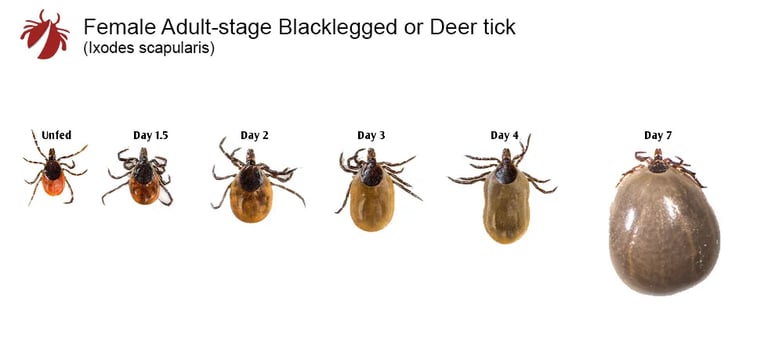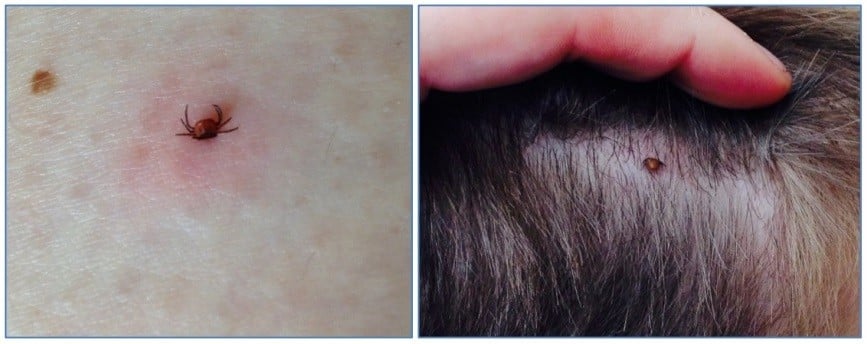ex Forces discount available - contact us now!
Understanding Ticks and Lyme Disease: What Every Outdoor Adventurer Should Know
If you spend time outdoors—walking, hiking, camping, or working—you’ve probably heard of Lyme disease. You might even know someone who’s had it. While vaccine research is finally making progress, your best defence right now is simple: don’t get bitten, and check yourself regularly.
OUTDOOR FIRST AID
10/12/20253 min read


What Is Lyme Disease and How Is It Spread?
Lyme disease is caused by the bacterium Borrelia burgdorferi, which is transmitted through the bite of infected deer ticks (Ixodes species). First recognised in 1975 in Lyme, Connecticut, the disease has since spread across the Northern Hemisphere, becoming its most common tick-borne illness.
Ticks don’t start out infected. They pick up bacteria from small animals—particularly mice—before passing it on to humans. In most areas, only 5–15% of ticks carry Lyme, and this varies by region and by year. Still, it only takes one infected tick to cause serious illness, so awareness matters.
Spotting Ticks: What They Look Like
Ticks go through several stages—larva, nymph, and adult—and grow in size as they feed:
Larvae: tiny, 6-legged, and least likely to be infectious
Nymphs: small but visible, 8-legged, highly active, and more likely to carry pathogens
Adults: the largest stage; females grow significantly after feeding
A tick’s body swells as it fills with your blood, sometimes becoming several times its original size.
Recognising Lyme Disease: Early Warning Signs
Catching Lyme disease early makes a huge difference. Look out for:
Erythema migrans (“bull’s-eye rash”)
A widening red rash that may appear 3–30 days after a bite. It can reach up to 30 cm wide.
Flu-like symptoms
Fever, chills, headaches, fatigue, swollen glands.
Joint problems
Intermittent pain or swelling, especially in large joints such as the knees.
Neurological symptoms
If untreated, Lyme may cause facial palsy, meningitis, and nerve pain or weakness.
If you develop any of these signs—especially after time outdoors—take action promptly.
How to Avoid Tick Bites
Ticks thrive in long grass, heather, leaf litter, and overgrown trails. Reduce your risk with simple precautions:
Avoid sitting or walking in tall vegetation when possible
Wear long sleeves and trousers; tuck trousers into socks
Use a DEET-based insect repellent (keep it away from climbing kit or expensive waterproofs)
Perform a full-body tick check after time outdoors
Keep informed about tick-borne illnesses in your area
Consider vaccination if recommended
Good habits go a long way toward preventing a ruined adventure.
Removing a Tick Properly
If you find a tick attached—don’t panic. Remove it as soon as possible:
Use fine-tipped tweezers
Grip the tick right at skin level.Pull upward steadily
No twisting, squeezing, or yanking.Clean the area
Use alcohol, iodine, or soap and water.Dispose of the tick safely
Seal it in a bag, submerge in alcohol, crush it, or flush it.Check yourself again
Ticks rarely travel alone.Monitor for rashes or symptoms
Signs of illness can appear weeks later.
❌ What NOT to do
No petroleum jelly, nail polish, heat, matches, or “smothering” methods. These stress the tick and increase the chance of infection.
When to See a Doctor
You should contact your GP if you:
have been bitten by a tick
develop a rash
experience flu-like or neurological symptoms
have been in an area known for ticks
Early treatment usually involves Doxycycline, which is highly effective when started quickly. Early blood tests can give false negatives because antibodies take time to develop, so symptoms and exposure history often matter more at first.
The Future: Lyme Disease Vaccination
As of 2024–2025, Pfizer and Valneva have completed the primary vaccination series for their Phase 3 trial: VALOR (Vaccine Against Lyme for Outdoor Recreationists). Results are being monitored through 2025, with regulatory submissions expected in 2026. This vaccine aims to protect people in both Europe and the U.S.—a huge step forward.
A Note on Tick-Borne Encephalitis (TBE)
TBE is a separate but serious viral infection carried by ticks, capable of causing meningitis or encephalitis. Cases previously linked mainly to travel abroad are now appearing within the UK, with 21 cases identified between 2015–2023 and a spike in 2022–2023. Vaccination is available, and the same prevention measures used for Lyme are essential.
The Bottom Line
Ticks are a part of the outdoors—but they don’t have to ruin your adventure.
With awareness, good habits, and quick action, you can dramatically lower your risk of Lyme disease and other tick-borne illnesses.
Stay informed. Stay vigilant. Stay adventurous.










Basecamp First Aid
Expert guidance for outdoor and workplace first aid training
Contact
Subscribe to newsletter for latest news and upcoming course information.
info@basecampfirstaid.com
07769 273116
© 2025. All rights reserved. Privacy Policy


